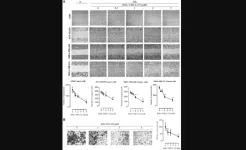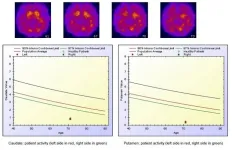(Press-News.org)
Cambridge, Mass. – On October 9, 2022, an intense pulse of gamma-ray radiation swept through our solar system, overwhelming gamma-ray detectors on numerous orbiting satellites, and sending astronomers on a chase to study the event using the most powerful telescopes in the world.
The new source, dubbed GRB 221009A for its discovery date, turned out to be the brightest gamma-ray burst (GRB) ever recorded.
In a new study that appears today in the Astrophysical Journal Letters, observations of GRB 221009A spanning from radio waves to gamma-rays, including critical millimeter-wave observations with the Center for Astrophysics | Harvard & Smithsonian’s Submillimeter Array (SMA) in Hawaii, shed new light on the decades-long quest to understand the origin of these extreme cosmic explosions.
The gamma-ray emission from GRB 221009A lasted over 300 seconds. Astronomers think that such "long-duration" GRBs are the birth cry of a black hole, formed as the core of a massive and rapidly spinning star collapses under its own weight. The newborn black hole launches powerful jets of plasma at near the speed of light, which pierce through the collapsing star and shine in gamma-rays.
With GRB 221009A being the brightest burst ever recorded, a real mystery lay in what would come after the initial burst of gamma-rays. “As the jets slam into gas surrounding the dying star, they produce a bright `afterglow’ of light across the entire spectrum," says Tanmoy Laskar, assistant professor of physics and astronomy at the University of Utah, and lead author of the study. "The afterglow fades quite rapidly, which means we have to be quick and nimble in capturing the light before it disappears, taking its secrets with it."
As part of a campaign to use the world’s best radio and millimeter telescopes to study the afterglow of GRB 221009A, astronomers Edo Berger and Yvette Cendes of the Center for Astrophysics (CfA) rapidly gathered data with the SMA.
“This burst, being so bright, provided a unique opportunity to explore the detailed behavior and evolution of an afterglow with unprecedented detail — we did not want to miss it!” says Edo Berger, professor of astronomy at Harvard University and the CfA. “I have been studying these events for more than twenty years, and this one was as exciting as the first GRB I ever observed.”
“Thanks to its rapid-response capability, we were able to quickly turn the SMA to the location of GRB 221009A,” says SMA project scientist and CfA researcher Garrett Keating. “The team was excited to see just how bright the afterglow of this GRB was, which we were able to continue to monitor for more than 10 days as it faded.”
After analyzing and combining the data from the SMA and other telescopes all over the world, the astronomers were flummoxed: the millimeter and radio wave measurements were much brighter than expected based on the visible and X-ray light.
“This is one of the most detailed datasets we have ever collected, and it is clear that the millimeter and radio data just don’t behave as expected,” says CfA research associate Yvette Cendes. “A few GRBs in the past have shown a brief excess of millimeter and radio emission that is thought to be the signature of a shockwave in the jet itself, but in GRB 221009A the excess emission behaves quite differently than in these past cases.”
She adds, “It is likely that we have discovered a completely new mechanism to produce excess millimeter and radio waves.”
One possibility, says Cendes, is that the powerful jet produced by GRB 221009A is more complex than in most GRBs. “It is possible that the visible and X-ray light are produced by one portion of the jet, while the early millimeter and radio waves are produced by a different component.”
“Luckily, this afterglow is so bright that we will continue to study its radio emission for months and maybe years to come,” adds Berger. “With this much longer time span we hope to decipher the mysterious origin of the early excess emission.”
Independent of the exact details of this particular GRB, the ability to respond rapidly to GRBs and similar events with millimeter-wave telescopes is an essential new capability for astronomers.
"A key lesson from this GRB is that without fast-acting radio and millimeter telescopes, such as the SMA, we would miss out on potential discoveries about the most extreme explosions in the universe,” says Berger. “We never know in advance when such events will occur, so we have to be as responsive as possible if we’re going to take advantage of these gifts from the cosmos.”
###
Additional Information
The Submillimeter Array is a joint project between the Smithsonian Astrophysical Observatory and the Academia Sinica Institute of Astronomy and Astrophysics and is funded by the Smithsonian Institution and the Academia Sinica. We recognize that Maunakea is a culturally important site for the indigenous Hawaiian people; we are privileged to study the cosmos from its summit.
About the Center for Astrophysics | Harvard & Smithsonian
The Center for Astrophysics | Harvard & Smithsonian is a collaboration between Harvard and the Smithsonian designed to ask—and ultimately answer—humanity's greatest unresolved questions about the nature of the universe. The Center for Astrophysics is headquartered in Cambridge, MA, with research facilities across the U.S. and around the world.
END
At 2AM of March 29, 2023 (Beijing Time), the Institute of High Energy Physics (IHEP) of the Chinese Academy of Sciences (CAS), together with some 40 research institutions worldwide, released their latest discoveries on the brightest Gamma-Ray Burst (dubbed as GRB 221009A) ever detected by human.
With the unique observations made by two Chinese space telescopes, namely Insight-HXMT and GECAM-C, scientists were able to accurately measure how bright and how much energy released by this burst, which is the key to understand this historical event.
For ...
A team of scientists led by the Department of Energy’s Oak Ridge National Laboratory designed a molecule that disrupts the infection mechanism of the SARS-CoV-2 coronavirus and could be used to develop new treatments for COVID-19 and other viral diseases.
The molecule targets a lesser-studied enzyme in COVID-19 research, PLpro, that helps the coronavirus multiply and hampers the host body’s immune response. The molecule, called a covalent inhibitor, forms a strong chemical bond with its intended protein target and thus increases its effectiveness as an antiviral treatment.
“We’re ...
GRAND RAPIDS, Mich. (March 28, 2023) — A team led by Van Andel Institute and Max Planck Institute of Immunobiology and Epigenetics scientists has identified two distinct subtypes of insulin-producing beta cells, or ß cells, each with crucial characteristics that may be leveraged to better understand and treat Type 1 and Type 2 diabetes.
ß cells are critical guardians of the body’s metabolic balance. They are the only cells capable of producing insulin, which regulates blood sugar levels by designating dietary sugar for immediate use ...
LAWRENCE — When the Kinks’ Ray Davies penned the tune “Last of the Steam-Powered Trains,” the vanishing locomotives stood as nostalgic symbols of a simpler English life. But for a paleontologist at the University of Kansas, the replacement of steam-powered trains with diesel and electric engines, as well as cars and trucks, might be a model of how some species in the fossil record died out.
Bruce Lieberman, professor of ecology & evolutionary biology and senior curator of invertebrate paleontology at the KU Biodiversity Institute & Natural History Museum, sought to use steam-engine history to test the merits of “competitive exclusion,” ...
“[...] mutations in G-proteins have been associated in the progress of several cancers [...]”
BUFFALO, NY- March 28, 2023 – A new research paper was published in Oncotarget's Volume 14 on March 24, 2023, entitled, “Polyisoprenylated cysteinyl amide inhibitors deplete singly polyisoprenylated monomeric G-proteins in lung and breast cancer cell lines.”
Finding effective therapies against cancers driven by mutant and/or overexpressed hyperactive G-proteins remains an area of active research. Polyisoprenylated cysteinyl amide inhibitors (PCAIs) are agents that mimic the essential posttranslational ...
Reston, VA—A newly published literature review sheds light on how nuclear medicine brain imaging can help evaluate the biological changes that cause chemotherapy-related cognitive impairment (CRCI), commonly known as chemo-brain. Armed with this information, patients can understand better the changes in their cognitive status during and after treatment. This summary of findings was published ahead-of-print by The Journal of Nuclear Medicine.
CRCI describes a clinical condition characterized by memory and concentration impairment, difficulties with information processing ...
IIASA researchers collaborated with the FAIRR Initiative – a collaborative investor network – on the development of a new IPCC-aligned climate risk analysis tool for investors. Analyses done using the new tool, show that climate-related cost increases could significantly affect the bottom lines of the largest listed livestock companies unless new strategies are urgently adopted.
The FAIRR Initiative today launched an enhanced iteration of its Coller FAIRR Climate Risk Tool providing investors with company-level data on how climate risks may impact costs and ...
The study surveyed school nurses working across the UK about their current working practices and experiences of working during the pandemic.
Dr Sarah Bekaert RN, Senior Lecturer in Child Health at Oxford Brookes University, said: “This research has highlighted the vital role school nurses play in the identification and prevention of issues that are likely to negatively impact young people as they navigate their teenage years, and then transition into adulthood.
“Our findings call for advocacy by policymakers and professional organisations ...
Understanding What Prevents Shared Decision Making From Wider Implementation With Black Patients
To understand the perspectives of Black patients on shared decision making (SDM) during medical appointments, researchers and clinicians investigated the preferences, needs and challenges around SDM as experienced by Black individuals. The team also offers possible adaptations and modifications for SDM models, practice and research within Black communities. The study team recruited 32 Black patients – 18 men and 17 women – with type ...
The transformative changes brought by deep learning and artificial intelligence are accompanied by immense costs. For example, OpenAI’s ChatGPT algorithm costs at least $100,000 every day to operate. This could be reduced with accelerators, or computer hardware designed to efficiently perform the specific operations of deep learning. However, such a device is only viable if it can be integrated with mainstream silicon-based computing hardware on the material level.
This was preventing the implementation of one highly promising deep learning ...








